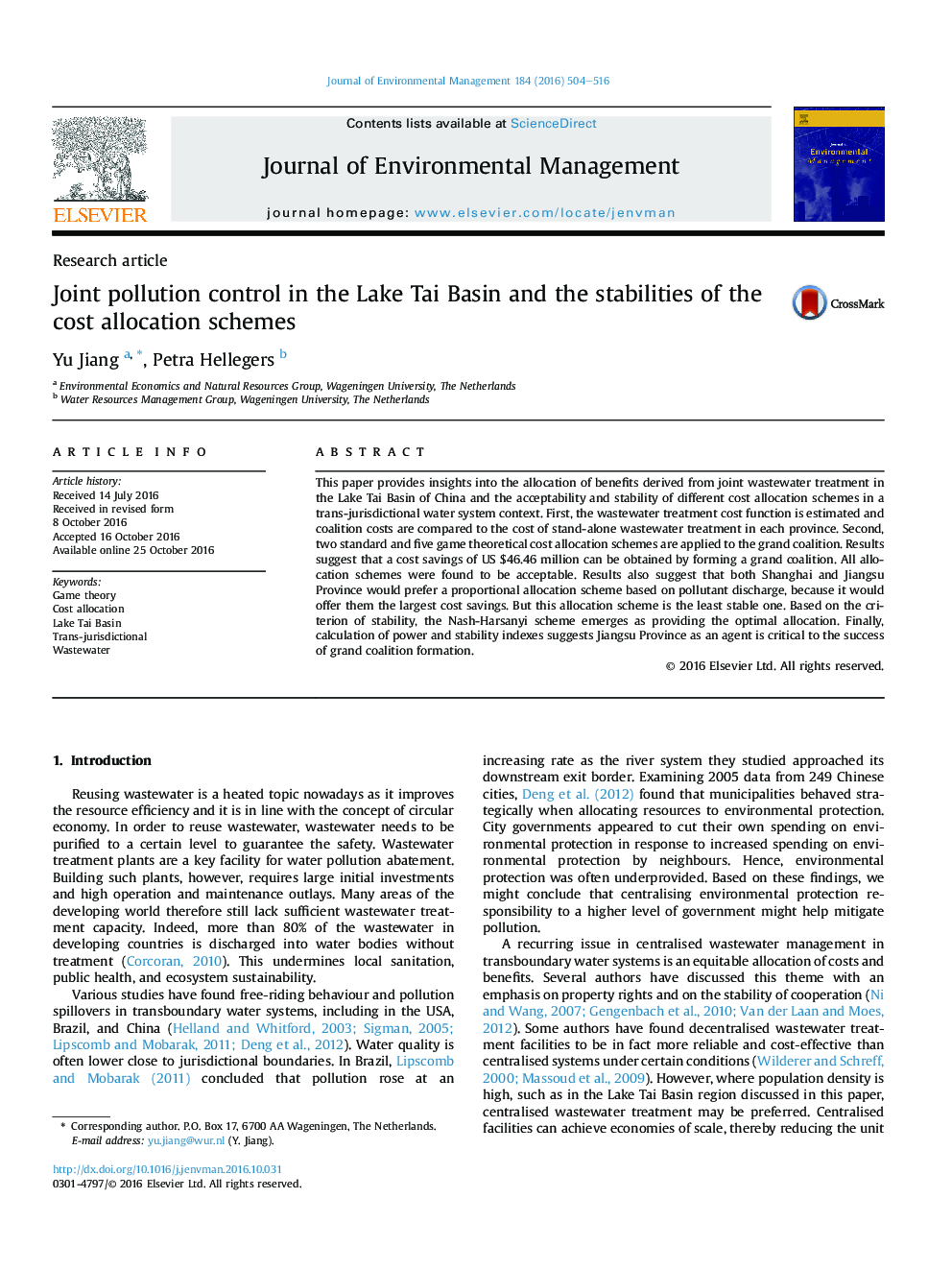| کد مقاله | کد نشریه | سال انتشار | مقاله انگلیسی | نسخه تمام متن |
|---|---|---|---|---|
| 5117162 | 1378117 | 2016 | 13 صفحه PDF | دانلود رایگان |
عنوان انگلیسی مقاله ISI
Joint pollution control in the Lake Tai Basin and the stabilities of the cost allocation schemes
ترجمه فارسی عنوان
کنترل آلودگی مشترک در حوضه دریاچه چابهار و پایداری طرحهای تخصیص هزینه
دانلود مقاله + سفارش ترجمه
دانلود مقاله ISI انگلیسی
رایگان برای ایرانیان
کلمات کلیدی
نظریه بازی، تخصیص هزینه، دریاچه تاز حوضه، فساد اداری، فاضلاب،
ترجمه چکیده
این مقاله بینش هایی را در مورد تخصیص مزایای حاصل از تصفیه فاضلاب مشترک در حوزه دریاچه چای چین و پذیرش و ثبات طرح های تخصیص هزینه های مختلف در یک سیستم آبرسانی فرامنطقه ای فراهم می کند. اولا، هزینه تابع هزینه های تصفیه فاضلاب برآورد شده و هزینه های ائتلاف با هزینه های تصفیه خانه فاضلاب در هر استان مقایسه می شود. دوم، دو طرح استاندارد و پنج تئوری تخصیص هزینه بازی به ائتلاف بزرگ اعمال می شود. نتایج نشان می دهد که با تشکیل یک ائتلاف بزرگ، صرفه جویی در هزینه 46.46 میلیون دلار می تواند حاصل شود. تمام طرح های تخصیص پذیرفته شدند. نتایج همچنین نشان می دهد که هر دو استان شانگهای و جیانگ سو طرح تخصیص متناسب را براساس تخلیه آلاینده ترجیح می دهند، زیرا این امر به آنها می تواند بیشترین صرفه جویی در هزینه را بدهد. اما این طرح تخصیص حداقل پایدار است. بر اساس معیار ثبات، طرح نوش-هارسانی به عنوان تخصیص بهینه ارائه می شود. در نهایت، محاسبه شاخص های قدرت و ثبات نشان می دهد استان جیانگ سو به عنوان یک عامل برای موفقیت تشکیل تشکیلات عالی ائتلافی حیاتی است.
موضوعات مرتبط
مهندسی و علوم پایه
مهندسی انرژی
انرژی های تجدید پذیر، توسعه پایدار و محیط زیست
چکیده انگلیسی
This paper provides insights into the allocation of benefits derived from joint wastewater treatment in the Lake Tai Basin of China and the acceptability and stability of different cost allocation schemes in a trans-jurisdictional water system context. First, the wastewater treatment cost function is estimated and coalition costs are compared to the cost of stand-alone wastewater treatment in each province. Second, two standard and five game theoretical cost allocation schemes are applied to the grand coalition. Results suggest that a cost savings of US $46.46 million can be obtained by forming a grand coalition. All allocation schemes were found to be acceptable. Results also suggest that both Shanghai and Jiangsu Province would prefer a proportional allocation scheme based on pollutant discharge, because it would offer them the largest cost savings. But this allocation scheme is the least stable one. Based on the criterion of stability, the Nash-Harsanyi scheme emerges as providing the optimal allocation. Finally, calculation of power and stability indexes suggests Jiangsu Province as an agent is critical to the success of grand coalition formation.
ناشر
Database: Elsevier - ScienceDirect (ساینس دایرکت)
Journal: Journal of Environmental Management - Volume 184, Part 3, 15 December 2016, Pages 504-516
Journal: Journal of Environmental Management - Volume 184, Part 3, 15 December 2016, Pages 504-516
نویسندگان
Yu Jiang, Petra Hellegers,
